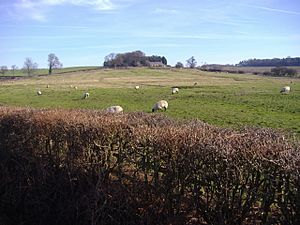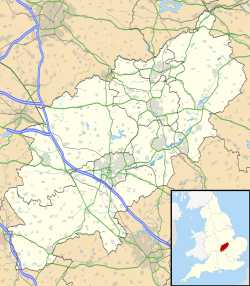Muscott (lost settlement) facts for kids
Quick facts for kids
Deserted village of Muscott
|
|
|---|---|
|
Lost Settlement
|
|

The site of the deserted village of Muscott
|
|
| Country | England |
| State | Northamptonshire |
| Region | East Midlands |
| District | Daventry |
| Municipality | Norton |
| Map Ref: SP627633 | |
The lost village of Muscott is located within the parish of Norton in the English county of Northamptonshire. It is a place where a village once stood, but now only traces remain. These "deserted villages" are like time capsules, showing us how people lived long ago. Muscott is one of many such sites found across England.
Contents
What is a Deserted Village?
A deserted village, also called a "lost settlement," is a place where a community once thrived but was later abandoned. Today, you might find only bumps and hollows in the ground. These marks show where houses, roads, and other buildings used to be.
Finding Lost Villages
Archaeologists and historians study these sites to learn about the past. They look at old maps, records, and even walk the land. Sometimes, special tools like ground-penetrating radar help them see what's hidden underground. This helps us imagine what life was like in places like Muscott.
Why Villages Disappear
Villages like Muscott didn't just vanish overnight. Many different reasons could cause people to leave their homes. These changes often happened slowly over many years or even centuries.
The Black Death's Impact
One major reason for villages disappearing was the Black Death. This terrible plague swept through Europe in the 1300s. It killed a huge number of people, sometimes half or more of a village's population. With so few people left, it became impossible to keep the village going.
Changes in Farming
Another big reason was changes in farming. In the Middle Ages, many villages relied on growing crops. Later, it became more profitable for landowners to raise sheep for wool. This meant they didn't need as many farm workers. Landlords might have forced villagers to leave their homes to turn farmland into sheep pastures.
Economic Hardship
Sometimes, villages simply couldn't make enough money to survive. Poor soil, bad harvests, or changes in trade routes could make life very difficult. If people couldn't find work or food, they would move to bigger towns or other villages.
Natural Disasters
Less commonly, natural disasters could also play a part. Floods, severe storms, or even changes in a river's course could make a village unlivable. While not common, these events could force people to abandon their homes.
Muscott's History
Muscott was once a living, breathing community. While we don't have all the details, we know it was part of the local landscape for a long time. Its story is similar to many other villages that slowly faded away.
What Remains Today
Today, Muscott is a quiet field, but if you look closely, you can still see signs of its past. The bumps and dips in the ground are the ghosts of old buildings. These earthworks are important clues that tell us about the village's layout.
Studying the Site
Studying sites like Muscott helps us understand medieval life. It shows us how people lived, worked, and built their communities. It also reminds us that history is all around us, even in seemingly empty fields.
Gallery



